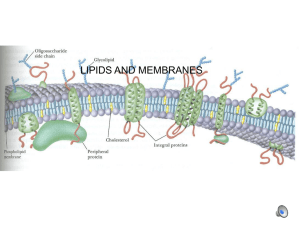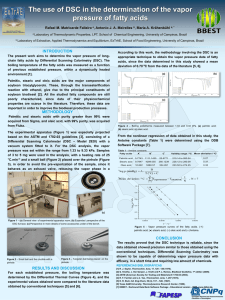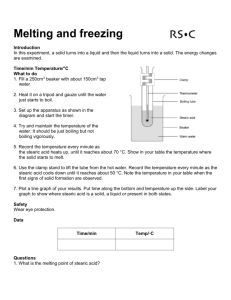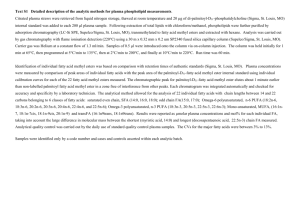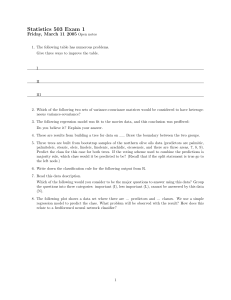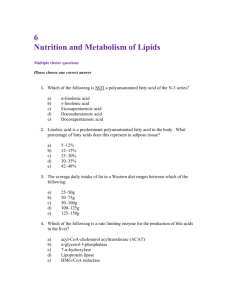Effect of diets rich in oleic acid, stearic acid and... postprandial haemostatic factors in young healthy men
advertisement
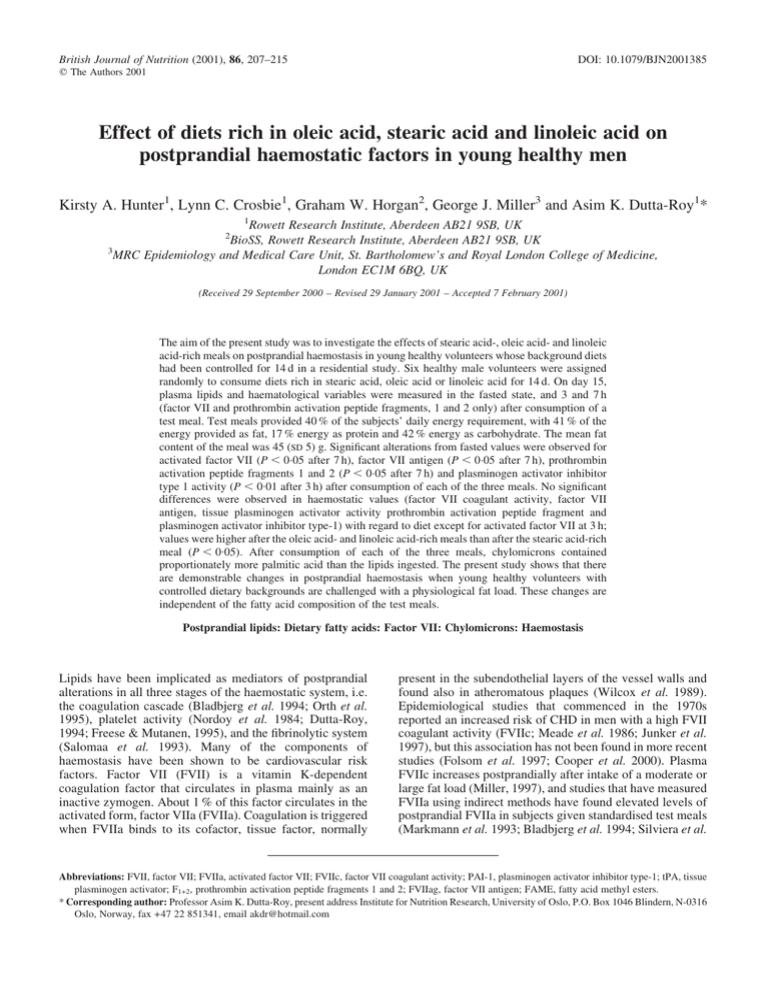
British Journal of Nutrition (2001), 86, 207–215 DOI: 10.1079/BJN2001385 q The Authors 2001 Effect of diets rich in oleic acid, stearic acid and linoleic acid on postprandial haemostatic factors in young healthy men Kirsty A. Hunter1, Lynn C. Crosbie1, Graham W. Horgan2, George J. Miller3 and Asim K. Dutta-Roy1* 1 Rowett Research Institute, Aberdeen AB21 9SB, UK BioSS, Rowett Research Institute, Aberdeen AB21 9SB, UK 3 MRC Epidemiology and Medical Care Unit, St. Bartholomew’s and Royal London College of Medicine, London EC1M 6BQ, UK 2 (Received 29 September 2000 – Revised 29 January 2001 – Accepted 7 February 2001) The aim of the present study was to investigate the effects of stearic acid-, oleic acid- and linoleic acid-rich meals on postprandial haemostasis in young healthy volunteers whose background diets had been controlled for 14 d in a residential study. Six healthy male volunteers were assigned randomly to consume diets rich in stearic acid, oleic acid or linoleic acid for 14 d. On day 15, plasma lipids and haematological variables were measured in the fasted state, and 3 and 7 h (factor VII and prothrombin activation peptide fragments, 1 and 2 only) after consumption of a test meal. Test meals provided 40 % of the subjects’ daily energy requirement, with 41 % of the energy provided as fat, 17 % energy as protein and 42 % energy as carbohydrate. The mean fat content of the meal was 45 (SD 5) g. Significant alterations from fasted values were observed for activated factor VII ðP , 0:05 after 7 h), factor VII antigen ðP , 0:05 after 7 h), prothrombin activation peptide fragments 1 and 2 ðP , 0:05 after 7 h) and plasminogen activator inhibitor type 1 activity ðP , 0:01 after 3 h) after consumption of each of the three meals. No significant differences were observed in haemostatic values (factor VII coagulant activity, factor VII antigen, tissue plasminogen activator activity prothrombin activation peptide fragment and plasminogen activator inhibitor type-1) with regard to diet except for activated factor VII at 3 h; values were higher after the oleic acid- and linoleic acid-rich meals than after the stearic acid-rich meal ðP , 0:05Þ: After consumption of each of the three meals, chylomicrons contained proportionately more palmitic acid than the lipids ingested. The present study shows that there are demonstrable changes in postprandial haemostasis when young healthy volunteers with controlled dietary backgrounds are challenged with a physiological fat load. These changes are independent of the fatty acid composition of the test meals. Postprandial lipids: Dietary fatty acids: Factor VII: Chylomicrons: Haemostasis Lipids have been implicated as mediators of postprandial alterations in all three stages of the haemostatic system, i.e. the coagulation cascade (Bladbjerg et al. 1994; Orth et al. 1995), platelet activity (Nordoy et al. 1984; Dutta-Roy, 1994; Freese & Mutanen, 1995), and the fibrinolytic system (Salomaa et al. 1993). Many of the components of haemostasis have been shown to be cardiovascular risk factors. Factor VII (FVII) is a vitamin K-dependent coagulation factor that circulates in plasma mainly as an inactive zymogen. About 1 % of this factor circulates in the activated form, factor VIIa (FVIIa). Coagulation is triggered when FVIIa binds to its cofactor, tissue factor, normally present in the subendothelial layers of the vessel walls and found also in atheromatous plaques (Wilcox et al. 1989). Epidemiological studies that commenced in the 1970s reported an increased risk of CHD in men with a high FVII coagulant activity (FVIIc; Meade et al. 1986; Junker et al. 1997), but this association has not been found in more recent studies (Folsom et al. 1997; Cooper et al. 2000). Plasma FVIIc increases postprandially after intake of a moderate or large fat load (Miller, 1997), and studies that have measured FVIIa using indirect methods have found elevated levels of postprandial FVIIa in subjects given standardised test meals (Markmann et al. 1993; Bladbjerg et al. 1994; Silviera et al. Abbreviations: FVII, factor VII; FVIIa, activated factor VII; FVIIc, factor VII coagulant activity; PAI-1, plasminogen activator inhibitor type-1; tPA, tissue plasminogen activator; F1+2, prothrombin activation peptide fragments 1 and 2; FVIIag, factor VII antigen; FAME, fatty acid methyl esters. * Corresponding author: Professor Asim K. Dutta-Roy, present address Institute for Nutrition Research, University of Oslo, P.O. Box 1046 Blindern, N-0316 Oslo, Norway, fax +47 22 851341, email akdr@hotmail.com 208 K. A. Hunter et al. 1994; Sanders et al. 1996). Plasma concentrations of plasminogen activator inhibitor type-1 (PAI-1) and tissue plasminogen activator (tPA) are also risk factors for an acute coronary event, and are reported to be affected during the postprandial state (Lopez-Segura et al. 1996). Several studies have shown that postprandial lipaemia is an important factor in the pathogenesis and progression of cardiovascular disease (Karpe et al. 1994). There have been few studies performed to establish whether individual fatty acids have distinctive postprandial effects on the haemostatic system, and the results of postprandial studies have often proved inconsistent, possibly due to differences in experimental design, such as meal composition and the background diets, and type of volunteer (Salomaa et al. 1993; Freese & Mutanen, 1995; Miller, 1997; Roche & Gibney, 1997). To date, therefore, firm conclusions of how specific fatty acids influence postprandial haemostatic response have not been reached. The present postprandial study was therefore carried out as an extension of an investigation of the effects of 2-week dietary periods of isoenergic diets rich in stearic acid (18 : 0), oleic acid (18 : 1n-9) or linoleic acid (18 : 2n-6) on fasting levels of haemostatic factors in young healthy volunteers under metabolically highly controlled conditions (Hunter et al. 2000). The fatty acids investigated were chosen because they are thought to induce potentially detrimental or beneficial changes in haemostatic function. Stearic acid is unique amongst the saturated fatty acids of similar chain length because it is considered to have little or no effect on plasma cholesterol concentration (Khosla & Sundram, 1996). Although the prevalence of stearic acid in the British diet is likely to increase with the introduction of synthetic fats designed to have minimal effect on plasma cholesterol concentration, its influence on haemostasis remains uncertain (Hoak, 1994). Oleic acid is an effective hypocholesterolaemic agent (Mattison & Grundy, 1985) and, as one of the key components in the increasingly advocated Mediterranean-style diet, has been hailed as a potential tool in the prevention of cardiovascular disease. Claims have been made of both beneficial and detrimental alterations in haemostasis when diets are supplemented with, or contain large amounts of, oleic acid (Barradas et al. 1990; Lopez-Segura et al. 1996; Sanders et al. 1996). The cholesterol-lowering properties of linoleic acid have been known for many years (Bronte-Stewart et al. 1955), but its effects on haemostasis are less well documented. In common with stearic acid and oleic acid, no firm conclusions have been drawn as to the net haemostatic response to large amounts of dietary linoleic acid. Dietary fat is composed principally of triacylglycerol, which after digestion and absorption stimulates the production of chylomicrons. The magnitude of the postprandial lipaemic response is determined by several factors: fasting plasma triacylglycerol concentration, age, sedentary lifestyle, amount of fat intake and habitual dietary fat composition (Kubow, 1996; Lambert et al. 1996). The fatty acid composition of chylomicrons is thought to reflect that of the previous meal (Kubow, 1996; Lambert et al. 1996), but the proportionate absorption of stearic acid is still uncertain. In the present study we determined chylomicron fatty acid profiles to assess the relative absorption rates of the fatty acids in the physiological-sized test meals. Since the consumption of large fat loads is known to induce raised FVIIc and to increase the level of activated FVIIa in the postprandial phase (Salomaa et al. 1993; Kapur et al. 1996), both these factors were measured to assess the effects of the distinct combinations of fatty acids in the test meals. Also measured was prothrombin activation peptide fragments 1 and 2 (F1+2) that is produced during the conversion of prothrombin to thrombin and is a sensitive marker of activation of the coagulation system. In addition, postprandial changes in the activity of fibrinolytic markers such as tPA and PAI-1 were measured. Materials and methods Subject recruitment The study protocol was approved by the Joint Ethical Committee of the Grampian Health Board, and the University of Aberdeen, Aberdeen, UK. Healthy male subjects aged 20 –35 years were recruited after satisfactory assessment of their medical and dietary history. Exclusion criteria were the presence of overt vascular, haematological or respiratory disease, diabetes, hypertension or infection (assessed by plasma C-reactive protein concentration), hyperlipidaemia, BMI , 20 kg/m2 or . 28 kg/m2, frequent consumption of drugs which affect lipid metabolism or haemostatic function (e.g. aspirin, paracetamol, ibuprofen, steroids), habitual consumption of fatty acid supplements such as fish oils, smoking, frequent blood donations, more than 8 h vigorous exercise per week and consumption of more than 30 units alcohol/week. General protocol The number of volunteers was chosen on the basis of the previous studies which have demonstrated that a sample size of six was sufficient to detect a 12 % increase in FVIIc for a ¼ 0:05 and b ¼ 0:80 (Sanders et al. 1996; Hunter et al. 1999). During each period of dietary control, subjects were resident in the Rowett Research Institute’s Human Nutrition Unit. Dietary periods were separated by wash-out intervals of more than 5 weeks when subjects returned home and consumed their habitual diet. Subjects were randomly assigned to consume one of three test diets for 2 weeks. The diets provided (% energy) 38 as fat, 45 as carbohydrate and 17 as protein (as assessed by compositional analyses) and were identical except for the fatty acid composition. The energy requirement of individual subjects was estimated as the product of the BMR (measured using a Deltatrac ventilated hood system, Datex-ohmeda, Stirling, Scotland) and a physical activity factor of 1:6. Of the dietary lipid in each diet 80 % was provided by one of three blended oils donated by Unilever Research (Vlaardingen, the Netherlands). The oils were rich in stearic and oleic acids, oleic acid or linoleic and oleic acids. The fatty acid component of the stearic acid-rich diet contained (%) 34 stearic, 37 oleic and 11 linoleic acids, the oleic acid-rich diet contained (%) 6 stearic, 66 oleic and 11 linoleic acids and the linoleic acidrich diet contained (%) 6 stearic, 38 oleic and 37 linoleic Fatty acids and postprandial haemostasis 209 Table 1. Fatty acid composition (% total fatty acids) of the blended experimental diets Fatty acid Stearic acid-rich diet Oleic acid-rich diet Linoleic acid-rich diet 0 :6 1 :6 10:0 34:1 36:6 10:8 1 :1 94:8 0 :6 1 :5 9 :9 6 :0 65:8 11:0 0 :7 95:5 0:5 1:5 11:2 6:0 38:0 36:5 1:3 95:0 12 : 0 14 : 0 16 : 0 18 : 0 18 : 1n-9 18 : 2n-6 18 : 3n-3 Total acids (Table 1). Further details of the test oils, diets (background and habitual) and assessment of compliance to the dietary regimen have been published previously (Hunter et al. 2000). Postprandial study For the postprandial study, subjects consumed a meal which was rich in the test oil that they had been consuming for the previous 2 weeks. Each test meal (stearic acid-rich, oleic acid-rich or linoleic acid-rich) provided 40 % of the subjects’ daily energy requirement, estimated as the product of the BMR and a physical activity factor of 1:5 (Hunter et al. 2000). The meals provided (% energy) 41 as fat, 42 as carbohydrate and 17 as protein, as assessed by compositional analysis, and were identical except for the fatty acid composition. The mean fat content of the meals was 45 (SD 4) g, 91 % of which was provided by the test oils. Meals consisted of breakfast cereal and skimmed milk, muffins with jam, beans-on-toast and a low-energy hot chocolate drink. Test oils were incorporated into the muffins and beans-on-toast. During the 7 h following consumption of the test meal subjects were allowed to consume water only. Procedure for blood sampling Subjects were asked to refrain from vigorous exercise on the day before each test meal to avoid any influence on haemostatic factors. Blood samples (60 ml) were taken after an overnight fast on day 14 after consumption of experimental diet for 2 weeks. After giving the fasted blood sample and consuming the test meal blood samples were taken at 3 h (60 ml) and 7 h (5 ml for the measurement of FVII and F1+2). Venous blood samples were taken using an 18 gauge butterfly needle and syringe system with minimal stasis after subjects had lain quietly for 30 min. Time of sampling was standardised across the three dietary periods to control for any effects of circadian variation of non-dietary origin. Blood for the measurement of FVIIc, FVIIa, factor VII antigen (FVIIag) and F1+2 was taken into 10 % (v/v) trisodium citrate (38 g/l) and centrifuged immediately at 2000 g for 10 min at room temperature. Plasma was frozen at 2808C for storage until analysis. Plasma FVIIc concentrations were measured by a one-stage clotting assay using rabbit brain thromboplastin (Diagnostic Reagents, Oxford, UK) and a FVII-deficient plasma (Miller et al. 1994). Plasma FVIIa concentrations were determined by a one-stage clotting assay as described by Morrissey et al. (1993). FVIIag concentration was measured using ELISA (Asserachrom VII:Ag; Diagnostica Stago, Asnieres-surSeine, France). Chromogenic methods were used for both tPA (Coatest tPA; Chromogenix AB, Molndal, Sweden) and PAI-1 (Coatest PAI-1; Chromogenix AB) activity measurements. F1+2 was measured by enzyme immunoassay (Behring Diagnostics, Marburg, Germany). Blood for the measurement of plasma fibrinopeptide A concentration was taken into a special anticoagulant containing EDTA, trasylol and chloromethylketone, and concentrations were determined by radioimmunoassay (Byk-Sangtec, Dietzenbach, Germany). The F1+2 data were excluded, when plasma concentrations of plasma fibrinopeptide A were . 6 ng/ml, indicative of a substandard venepuncture (Miller et al. 1995). Blood (4:5 ml)for the measurement of plasma triacylglycerol and C-reactive protein concentrations was taken into 0:054 ml 15 % (w/v) EDTA. After centrifuging at 2000 g for 10 min, plasma was removed and stored at 48C for the measurement of triacylglycerol concentrations and 2208C for the determination of C-reactive protein concentration. Plasma triacylglycerols were measured within 4 d by an automated enzymic method (Kone Dynamic Selective Chemistry Analyser, Ruukinite, Finland) and C-reactive protein concentration was determined using a latex agglutination kit (Behring Diagnostics, Marburg, Germany). If plasma C-reactive protein concentration was elevated (indicating the presence of an acute-phase response), the blood sample was excluded from all analyses. Plasma HDL and total cholesterol concentrations were determined using kits from Sigma (Poole, Dorset, UK). Plasma LDL-cholesterol was calculated using the Friedewald formula (Friedewald et al. 1972). Blood (5 ml) for the isolation of chylomicrons was taken into 0 :054 ml 15 % (w/v) EDTA and subsequently transferred into tubes containing 125 ml 4 % (w/v) EDTA, 40 ml 1 % (w/v) gentamycin sulfate, 25 ml 1 % (v/v) butylated hydroxytoluene and 140 ml 0 :3 M-NaCl as described by Schumaker & Puppione (1986). After centrifuging at 2000 g for 10 min, plasma was removed and stored at 48C in a tube containing 25 ml 4 % (w/v) EDTA, 12:5 ml 1 % (v/v) butylated hydroxytoluene, 12:5 ml 0:2 M-phenylmethanesulfonyl fluoride and 12:5 ml 1 % (w/v) gentamycin sulfate for a maximum of 3 d. Chylomicrons were isolated from plasma by floatation centrifugation as described by Lindgren et al. (1972). Mock plasma solution (10 ml) having the same density as 210 K. A. Hunter et al. plasma (11:42 g NaCl and 100 mg Na2EDTA/l; density 1:0063 g/ml) was layered slowly onto the plasma from 5 ml blood. This solution was then centrifuged at 25 000 rpm for 80 min at 198C. The chylomicron layer present at the top of the plasma –mock plasma solution was removed, placed in a separate tube and washed with 10 ml mock plasma. After centrifugation (at the settings described earlier), the chylomicron layer was removed and stored in 0:5 ml mock plasma at 2808C until required for fatty acid analysis. reasonably normally distributed. Post hoc t tests were used to compare 3 h and 7 h measurements with fasting values for each diet. A one-way ANOVA, blocked for subject, was used to compare baseline and 2-week data between diets. Results Effects on plasma triacylglycerol The mean age, weight and BMI for the six subjects were 28:0 (SD 5:6) years, 78:1 (SD 10:74) kg, and 24:7 (SD 2:2) kg/m2 respectively (n 6). Table 2 shows the lipid profiles after an overnight fast and 3 h after consumption of the test meals. Consumption of all three meals resulted in a significant increase in plasma triacylglycerol concentrations compared with fasting values (180 – 212 % of fasting values after 3 h; P , 0:05Þ: This moderate increase reflected the physiological lipid content of the meal (45 (SD 4) g). There were no significant differences in the postprandial plasma triacylglycerol responses to the test meals (i.e. there was a similar triacylglycerol response to meals with different fatty acid composition). No statistically significant differences between fasting and 3-h postprandial levels of plasma total cholesterol, LDL- or HDL-cholesterol were observed for any of the test meals. Chylomicron fatty acid analysis Chylomicron fatty acids were extracted according to the method of Bligh & Dyer (1959). Fatty acid methyl esters (FAME) were analysed using Hewlett Packard gas chromatograph (HP 6890 series; Hewlett Packard Palo Alto, CA, USA), fitted with a 30 m 50 % cyanopropyl methyl polysiloxane capillary column with 0:25 mm i.d., using a split ratio of 50:1. The injection and detection temperatures were 2508C and He was used as carrier gas. The starting temperature of the column was 808C; was increased to 1808C at a rate of 258C/min. After 4 min at 1808C, the temperature was increased to 2208C at a rate of 18C/min. A standard mixture of FAME was used to identify the FAME in the samples by means of retention time. Chromatograms were analysed using HP Chemstation software (Hewlett Packard). Effects on haemostatic factors Mean plasma levels of FVIIa, FVIIag, PAI-1, tPA, FVIIc, and F1+2 in the fasting and postprandial states are presented in Table 3. Compared with fasting values, there were no significant changes in FVIIc after consumption of the three test meals. By contrast, FVIIa increased postprandially after consumption of all three test meals. FVIIa was significantly higher 3 h postprandially after the oleic acid-rich and linoleic acid-rich meals ðP , 0:001 for both meals) and significantly higher for all three meals at 7 h (each P , 0:05Þ: Compared with fasting values, plasma FVIIag tended Statistical analysis Data are expressed as means and standard deviations. Data were analysed by a hierarchical (split-plot) ANOVA, with terms for diet in the between-subject stratum, and for time and diet time interaction in the within-subject stratum. Interaction terms between diet and the fasting –3 h and fasting –7 h contrasts were also fitted. Data appeared to be Table 2. Plasma lipid concentrations (mmol/l) after an overnight fast and at 3 h after test meals rich in stearic acid, oleic acid and linoleic acid in six young healthy volunteers† (Mean values and standard deviations) Stearic acid-rich Test meal Mean Triacylglycerols Fasting 0:67 3h 1:28* Total cholesterol Fasting 3:77 3h 3:67 LDL-cholesterol Fasting 2:78 3h 2:74 HDL-cholesterol Fasting 0:98 3h 0:93 Oleic acid-rich Linoleic acid-rich SD Mean SD Mean SD 0:42 0:23 0:64 1:36* 0:41 0:27 0:60 1:32* 0:27 0:48 0:65 0:73 4:04 3:83 0:78 0:81 3:70 3:81 0:75 0:93 0:68 0:77 3:05 2:91 0:96 0:92 2:70 3:14 0:78 0:71 0:20 0:12 0:99 0:91 0:28 0:16 0:99 0:85 0:15 0:32 Mean values were significantly different from the corresponding fasting values: *P , 0:05: † For details of subjects and experimental procedures, see p. 208. Fatty acids and postprandial haemostasis 211 Table 3. Plasma haemostatic factors in the fasted and postprandial state following consumption of test meals rich in stearic acid, oleic acid and linoleic acid in six young healthy volunteers† (Mean values and standard deviations) Stearic acid-rich Test meal Mean FVIIc (% standard) Fasting 88:84 3h 88:84 7h 92:18 FVIIa (ng/ml) Fasting 2:52 3h 2:59 7h 3:30 FVIIag (% standard) Fasting 72:11 3h 73:74 7h 76:54 PAI-1 activity (IU/ml) Fasting 10:44 3h 6:37 tPA activity (IU/ml) Fasting 1:58 3h 0:82 F1+2 (nmol/l) Fasting 0:59 3h 0:63 7h 0:64 SD 23:30 21:31 29:86 Oleic acid-rich Linoleic acid-rich Mean SD Mean SD 94:50 95:21 96:21 17:81 23:17 23:99 89:67 92:56 95:56 15:26 21:41 20:08 0:82 2:59 1:25* 2:20 3:40 3:58 1:10 1:40*** 1:96* 2:55 3:61 3:57 0:94 0:98*** 1:01* 4:24 5:68 6:96* 71:49 68:63 76:63 9:28 6:45 8:01* 74:78 70:44 75:44 6:34 5:24 5:44* 7:98 2:02** 11:73 6:63 7:64 4:34** 13:01 8:91 9:47 5:98** 0:73 0:35 1:03 1:52 0:62 0:87 1:94 1:20 1:52 0:88 0:13 0:14 0:16* 0:62 0:63 0:68 0:21 0:18 0:17* 0:61 0:65 0:67 0:23 0:21 0:15* FVIIc, factor VII coagulant activity; FVIIa, activated factor VII; FVIIag, factor VII antigen; PAI-1, plasminogen activator inhibitor type-1; tPA, tissue plasminogen activator; F1+2, prothrombin activation peptide fragments 1 and 2. Mean values were significantly different from the corresponding fasting values: * P , 0:05; ** P , 0:01; *** P , 0:001: † For details of subjects and experimental procedures, see p. 208. to decrease after the first 3 h following the oleic acid-rich and linoleic acid-rich meals ðP ¼ 0:06Þ; but not after the stearic acid-rich meal. At 7 h after all test meals, FVIIag was slightly but statistically significantly higher ðP , 0:05 for all meals) than fasting values. After consumption of all three test meals, F1+2 was significantly higher 7 h postprandially compared with fasting values ðP , 0:05Þ: This response was similar for all three test meals. Compared with fasting values, there was no change in plasma tPA activity at 3 h during any test-meal period, but PAI-1 activity decreased by similar amounts after all three test meals ðP , 0:01Þ: Chylomicron fatty acid profiles Fatty acid profiles of chylomicrons isolated 3 h after consumption of the meals are shown in Fig. 1 together with the fatty acid composition (% total fatty acids) of the respective test meals. In general, the fatty acid composition of the isolated chylomicrons reflected that of the lipid in the meals. However, a number of significant differences were observed for several fatty acids. After the stearic acid-rich meal, the stearic acid level in chylomicrons was less than that in the meal ðP , 0:05Þ; whereas palmitic acid ðP ¼ 0:05Þ and linoleic acid ðP , 0:05Þ levels were higher in chylomicrons than in this meal. After consumption of the oleic acid-rich meal, palmitic acid ðP , 0:05Þ and linoleic acid ðP , 0:01Þ levels were higher in chylomicrons than in the meal, whereas no difference in oleic acid or stearic acid levels was observed between the meal and the chylomicrons. After the linoleic acid-rich meal, palmitic acid ðP , 0:05Þ; stearic acid ðP , 0:001Þ and linoleic acid ðP , 0:01Þ levels were higher in chylomicrons. Oleic acid was lower in chylomicrons than in the meal, but the difference was not statistically significant. To assess differences between diets, the amount of each fatty acid (% total fatty acids) was subtracted from the amount in chylomicrons and then a oneway ANOVA was performed. For all meals, there was a significantly greater percentage of palmitic acid present in chylomicrons compared with the meal. This difference was greater for the stearic acid-rich and linoleic acid-rich meals than for the oleic acid-rich meal. For all meals, the linoleic acid level in chylomicrons was significantly higher than that in the meal. Palmitic acid:stearic acid was determined for chylomicrons, as described by Bonanome & Grundy (1989), to provide an indication of the relative rate of absorption of these two saturated fatty acids. Stearic acid:oleic acid was also calculated (oleic acid, a monounsaturated fatty acid is thought to be absorbed with almost 100 % efficiency). Palmitic acid:stearic acid in chylomicrons differed between the three meals (0:48 for the stearic acid-rich meal, 1:61 for the oleic acid-rich meal, 2:05 for the linoleic acid-rich meal). Significant differences were also observed for stearic acid:oleic acid (0:82 for the stearic acid-rich meal, 0:10 for the oleic acid-rich meal, 0:21 for the linoleic acid-rich meal). 212 K. A. Hunter et al. Fig. 1. Fatty acid composition (% total fatty acids) of chylomicrons (r) following consumption of the (a) stearic, (b) oleic and (c) linoleic acidrich meals (D) by six young healthy volunteers. For details of subjects and experimental procedure see p. 208. Values are means and standard deviations represented by vertical bars. Mean values were significantly different from those for meal composition: *P , 0:05; **P , 0:01; ***P , 0:001Þ: Discussion On the basis that human subjects are in postprandial state over much of a 24 h period, and that processes of atherogenesis and thrombosis may be accelerated as a result of changes in the haemostatic system which occur during consumption of lipid nutrients (Miller, 1997), researchers are focusing increasingly on postprandial metabolism and how specific dietary components can modify haemostatic properties during this period. In the light of the importance of plasma triacylglycerol concentrations and the variability in plasma triacylglycerol associated with dietary fat intake, the body of research investigating the relationship between postprandial triacylglycerol metabolism and CHD is growing (Miller, 1997). Manipulation of the type and amount of fatty acids in the diet is a potential strategy for influencing the haemostatic properties of the blood in both the fasting and postprandial states without the use of drugs or extreme changes in lifestyle. However, a major limitation of many of the Fatty acids and postprandial haemostasis postprandial studies carried out so far has been that the background diets of the volunteers were not controlled (Salomaa et al. 1993; Freese & Mutanen, 1995 Miller, 1997; Roche & Gibney 1997). Thus, the observed differences in the postprandial haemostatic responses may not have been due to the differences in the fatty acids ingested alone. The present study has overcome the potential effect of habitual diets as the volunteers were on strictly metabolically controlled dietary regimens for 2 weeks before the postprandial study (Hunter et al. 2000). The present study investigated the effects of stearic acid, oleic and linoleic acid in a physiologically-sized meal on a number of postprandial haemostatic factors in healthy young men with a controlled dietary background. Test meals were consumed after subjects had been ‘conditioned’ to high intakes of the test fatty acids by consuming diets containing large amounts of the same fatty acids for 2 weeks. The present study demonstrated significant alterations from fasting values for FVIIa, FVIIag, F1+2 and PAI-1 activity in the postprandial state following all three meals. With the single exception of FVIIa, the changes were independent of the fatty acid composition of the meal. FVIIa values at 3 h were higher following the oleic acid- and linoleic acid-rich meals as compared with the stearic acid-rich meal. Plasma FVIIc and tPA activity did not change from fasting levels following meals. It is generally accepted that a substantial fat load is necessary to induce an increase in FVIIc, especially in younger adults, and the amount used in the present study was not large enough in this respect. The literature relating to the effect of dietary fat composition on postprandial FVII activity is confusing, and the relevant studies need to be considered in terms of their study design. There are reports suggesting that a saturated fatty acid-rich meal had a more pro-coagulant effect than polyunsaturated fatty acids (Mitopoulos et al. 1994), whereas other studies (Miller et al. 1991; Roche & Gibney, 1997), including the present study, failed to demonstrate such an effect. Although early in vitro experiments suggested that stearic acid may be prothrombogenic when unbound in the blood (Hoak, 1994), and an epidemiological study proposed that plasma stearic acid concentration is an independent predictor of FVIIc (Girelli et al. 1996), human intervention studies have not consistently confirmed these findings. Tholstrup et al. (1996), for example, observed that although a high-fat meal rich in stearic acid tended to increase FVIIc and bthromboglobulin postprandially, fibrinolytic activity was increased and platelet aggregatory response to collagen and ADP were decreased, making the overall effect on thrombotic tendency difficult to establish. Although it has been proposed that the particular effects of stearic acid may be a consequence of impaired absorption, studies in human subjects have suggested that stearic acid is absorbed at a rate comparable to that of other saturated fatty acids, e.g. palmitic acid (Emken, 1994). The overall effect of oleic acid on the haemostatic system also remains unresolved. Barradas et al. (1990), for example, observed a reduction in platelet aggregation and thromboxane A2 release following 8 weeks of supplementation with 21 g olive oil/d, whereas Lopez-Segura et al. (1996) demonstrated a significant reduction in PAI-1 plasma activity and antigen 213 after 24 d on a diet rich in monounsaturated fatty acids (predominantly oleic acid). Sanders et al. (1996) reported a potentially detrimental effect of a meal containing 90 g olive oil by finding a significant increase in FVIIc 7 h after a test meal. We found a small but statistically significant ðP , 0:05Þ postprandial increase in F1+2 levels in subjects following all three meals, together with the increase in FVIIa ðP , 0:05Þ and triacylglycerol ðP , 0:05Þ levels. Postprandial elevation of FVIIa would also produce intermittent activation of FX to FXa, and subsequently F1+2, an activation peptide released after conversion of prothrombin to thrombin (Dutta-Roy et al. 1986). Thus, there may be a biological relationship between postprandial elevation of FVIIa and F1+2. The present study also shows a general decrease in postprandial PAI-1 activity, but no effect on tPA activity after all three meals. Triacylglycerol-rich chylomicrons transport dietary triacylglycerol within the circulation, causing an increase in plasma triacylglycerol concentrations. Thus, an increase in plasma triacylglycerol concentrations is a normal metabolic consequence of ingestion of dietary fat. However, elevated postprandial plasma triacylglycerol concentrations are associated with several adverse metabolic events, including formation of atherogenic chylomicron remnants, the formation of small dense LDL particles and the reduction of plasma HDL-cholesterol concentrations (Karpe et al. 1994). The fatty acid composition of chylomicrons is thought to determine their size and clearance from the circulation. After all three meals, chylomicrons contained more palmitic acid and generally less oleic acid than the meals, suggesting that the relative absorption rate of palmitic acid is higher than that of oleic acid. We obtained similar results when volunteers consumed specific structurally defined triacylglycerols (1,3-distearoyl-2-oleoyl glycerol, trioleine, 1, 3-dilinoleoyl-2-oleoyol glycerol) containing these fatty acids in physiologically-sized meals (Hunter et al. 1999). However, the validity of the observation is based on the assumption that chylomicron triacylglycerols are hydrolysed by lipoprotein lipase at similar rates irrespective of their fatty acid composition. Palmitic acid, 16:0, at sn-2 position in triacylglycerols, is well absorbed (Aoe et al. 1997). Chylomicrons contained relatively more palmitic acid than oleic acid, suggesting a greater absorption rate of palmitic acid as compared with oleic acid. However, endogenous production of palmitic acid by the intestinal enterocytes may be one of the contributing factors. The proportions of individual fatty acids were altered by the processes of digestion, absorption and secretion associated with the formation of chylomicrons. It is also important to note that this method does not provide a measurement of absolute absorption rates, but only of relative absorption rates within a particular mix of fatty acids in the test meal. Many studies investigating the postprandial effects of lipids suffer from the limitation that the fat load given is fairly large and unrepresentative of the typical fat content of a meal, so that extrapolation of results to real-life situations is not possible. The present study, however, demonstrates clearly that the consumption of meals containing a 214 K. A. Hunter et al. physiological fat load by healthy young individuals induced potentially pro-coagulant alterations in the haemostatic system. In addition, these changes were independent of the fatty acid composition of the test meal, being evident when meals were rich in stearic, oleic or linoleic acids. Acknowledgements This work was supported by the Ministry of Agriculture, Fisheries and Food UK, and the Scottish Executive Rural Affairs Department. We thank the Unilever Research, Vlaardingen, The Netherlands, for their gift of test oils. References Aoe S, Yamamura J-C, Matsuyama H, Hase M, Shiota M & Miura S (1997) The positional distribution of dioleoyl-palmitoyl glycerol influences lymph chylomicron transport, composition and size in rat. Journal of Nutrition 127, 1269– 1273. Barradas MA, Christofides JA, Jeremy JY, Mikhailidis DP, Fry DE & Dandona P (1990) The effect of olive oil supplementation on human platelet function, serum cholesterol-related variables and plasma fibrinogen concentrations: a pilot study. Nutrition Research 10, 403– 411. Bladbjerg EM, Marckmann P, Sandstrom B & Jespersen J (1994) Non-fasting factor VII coagulant activity (FVII:C) increased by high-fat diet. Thrombosis and Haemostasis 71, 755–758. Bligh BE & Dyer WJ (1959) A rapid method of total lipid extraction and purification. Canadian Journal of Biochemistry and Physiology 37, 911– 917. Bonanome A & Grundy S (1989) Intestinal absorption of stearic acid after consumption of high fat meals in humans. Journal of Nutrition 119, 1556– 1560. Bronte-Stewart B, Keys A, Brock JF, Moodie AD, Keys MH & Anronis A (1955) Serum cholesterol, diet and coronary heart disease: an inter-racial survey in the Cape Peninsula. Lancet ii, 1103– 1108. Cooper JA, Miller GJ, Bauer KA, Morrissey JH, Meade TW, Howarth DJ, Barzegar S, Mitchell JP & Rosenberg RD (2000) Comparison of novel haemostatic factors and conventional risk factors for prediction of coronary heart disease. Circulation 102, 2816– 2822. Dutta-Roy AK (1994) Insulin mediated processes in platelets, erythrocytes and monocytes/macrophages: Effects of essential fatty acid metabolism. Prostaglandins Leukotrienes and Essential Fatty Acids 51, 385– 399. Dutta-Roy AK, Ray TK & Sinha AK (1986) Prostacyclin stimulation of the activation of blood coagulation factor X by platelets. Science 231, 385–389. Emken EA (1994) Metabolism of dietary stearic acid relative to other fatty acids in human subjects. American Journal of Clinical Nutrition 60, Suppl., 1023S– 1028S. Folsom AR, Wu KK, Rosamond WD, Sharret AR & Chambless LE (1997) Prospective study of hemostatic factors and incidence of coronary heart disease: the atheroslcerotic risk in communities (ARIC) study. Circulation 96, 1102– 1108. Freese R & Mutanen M (1995) Postprandial changes in platelet function and coagulation factors after high-fat meals with different fatty acid compositions. European Journal of Clinical Investigation 49, 658– 664. Friedewald WJ, Levy RJ & Fredrickson DS (1972) Estimation of the concentration of low density lipoprotein cholesterol in plasma without use of preparative ultracentrifuge. Clinical Chemistry 18, 499– 506. Girelli D, Olivieri O, Argliano PL, Guarini P, Bassi A & Corrocher R (1996) Influences of lipid and non-lipid nutritional parameters on factor VII coagulant activity in normal subjects: the Nove Study. European Journal of Clinical Investigation 26, 199– 204. Hoak JC (1994) Stearic acid, clotting, and thrombosis. American Journal of Clinical Nutrition 60, Suppl., 1050S– 1053S. Hunter KA, Crosbie LC, Weir A, Miller GJ & Dutta-Roy AK (1999) The effects of structurally defined triglycerides of differing fatty acid composition on postprandial haemostasis in young, healthy men. Atherosclerosis 142, 151– 158. Hunter KA, Crosbie LC, Weir A, Miller GJ & Dutta-Roy AK (2000) A residential study comparing the effects of diets rich in stearic acid, oleic acid and linoleic acid on fasting blood lipids and haemostatic variables in young healthy men. Journal of Nutritional Biochemistry 11, 408– 416. Junker R, Heinrich J, VandeLoo J & Assmann G (1997) Coagulation factor VII and the risk of coronary heart disease in healthy men. Arteriosclerosis, Thrombosis and Vascular Biology 17, 1539– 1544. Kapur R, Hoffman CJ, Bhushan V & Hultin MB (1996) Postprandial elevation of activated factor VII in young adults. Arteriosclerosis, Thrombosis and Vascular Biology 16, 1327– 1332. Karpe F, Steiner G, Uffelmann K, Olivecrona T & Hamsten A (1994) Postprandial lipoproteins and progression of coronary atherosclerosis. Atherosclerosis 106, 83 – 92. Khosla P & Sundram K (1996) Effects of dietary fatty acid composition on plasma cholesterol. Progress in Lipid Research 35, 93 – 132. Kubow S (1996) The influence of positional distribution of fatty acids in native, interesterified and structure-specific lipids on lipoprotein metabolism and atherogenesis. Journal of Nutritional Biochemistry 7, 530– 541. Lambert MC, Botham KM & Mayes PA (1996) Modification of the fatty acid composition of dietary oils and fats on incorporation into chylomicrons and chylomicron remnants. British Journal of Nutrition 76, 435– 445. Lindgren FT, Jensen LC & Hatch FT (1972) The isolation and quantitation of serum lipoproteins. In Blood Lipids and Lipoproteins: Quantitation, Composition and Metabolism, pp. 181– 274 [GJ Nelson, editor]. New York: Wiley-Interscience. Lopez-Segura F, Velasco F, Lopez-Miranda J, Castro P, LopezPedrera J, Torres A, Trujillo J, Ordovas JM & Perez-Jimenez F (1996) Monounsaturated fatty acid-enriched diet decreases plasma plasminogen activator inhibitor type 1. Arteriosclerosis, Thrombosis and Vascular Biology 16, 82 – 88. Marckmann P, Sandstrom B & Jesepersen J (1993) Dietary effects on circadian fluctuation in human blood coagulation factor VII and fibrinolysis. Atherosclerosis 101, 225–234. Mattson FH & Grundy SM (1985) Comparison of the effects of dietary saturated, monounsaturated and polyunsaturated fatty acids on plasma lipids and lipoproteins in man. Journal of Lipid Research 26, 194– 202. Meade TW, Mellows S, Brozovic MM, Miller GJ, Chakrabarti RR, North WRS, Haines AP, Stirling Y, Imeson JD & Thomson SG (1986) Haemostatic function and ischaemic heart disease: principal results of the Northwick Park Heart study. Lancet ii, 533– 537. Miller GJ (1997) Dietary fatty acids and blood coagulation. Prostaglandins Leukotrienes and Essential Fatty Acids 57, 389– 394. Miller GJ, Bauer KA, Barzegar S, Foley AJ, Mitchell JP, Cooper JA & Rosenberg RD (1995) The effects of quality and timing of venepuncture on markers of blood coagulation in healthy middle-aged men. Thrombosis and Haemostasis 73, 81 – 86. Miller GJ, Martin JC, Mitropoulos KA, Reeves BEA, Thompson RL, Meade TW, Cooper JA & Cruickshank JK (1991) Plasma factor VII is activated by postprandial triglyceridaemia Fatty acids and postprandial haemostasis irrespective of dietary fat composition. Atherosclerosis 86, 163–171. Miller GJ, Stirling Y, Esnouf MP, Heinrich J, van de Loo J, Kienast J, Wu KK, Morrissey JH, Meade TW, Martin JC, Imeson JD, Cooper JA & Finch A (1994) Factor VII-deficient plasmas depleted of protein C raise the sensitivity of the factor VII bioassay to activated factor VII: an international study. Thrombosis and Haemostasis 71, 38 – 45. Mitropoulos KA, Miller GJ, Martin C, Reeves BEA & Cooper JA (1994) Dietary fat induces changes in factor VII coagulant activity through effects on plasma free stearic acid concentrations. Arteriosclerosis and Thrombosis 4, 943– 951. Morrissey JH, Macik BG, Neuenschwander PF & Comp PC (1993) Quantitation of activated factor VII levels in plasma using a tissue factor mutant selectively deficient in promoting factor VII activation. Blood 81, 734– 744. Nordoy A, Lagarde M & Renaud S (1984) Platelets during alimentary hyperlipaemia induced by cream and cod liver oil. European Journal of Clinical Investigation 14, 339– 345. Orth M, Luley C, Mayer H & Wieland H (1995) Responsiveness of ATIII and coagulation factors V and VII to a standardised oral fat load. Thrombosis Research 80, 265–270. Roche HM & Gibney MJ (1997) Postprandial coagulation factor 215 VII activity: The effect of monounsaturated fatty acids. British Journal of Nutrition 77, 537– 549. Salomaa V, Rasi V, Pekkanen J, Jauhiainen M, Vahtera E, Pietinen P, Korhonen H, Kuulasmaa K & Ehnholm C (1993) The effects of saturated fat and n-6 polyunsaturated fat on postprandial lipaemia and hemostatic activity. Atherosclerosis 103, 1 – 11. Sanders TAB, Miller GJ, de Grassi T & Yahia N (1996) Postprandial activation of coagulant factor VII by long-chain dietary fatty acids. Thrombosis and Haemostasis 76, 369– 371. Schumaker VN & Puppione DL (1986) Sequential flotation ultracentrifugation. Methods in Enzymology 128, 155– 170. Silviera A, Karpe F, Blomback M, Steiner G, Walldius G & Hamsten A (1994) Activation of coagulation factor VII during alimentary lipemia. Arteriosclerosis and Thrombosis 14, 60 – 69. Tholstrup T, Andreasen K & Sandstrom B (1996) Acute effect of high-fat meals rich in either stearic or myristic acid on hemostatic factors in healthy young men. American Journal of Clinical Nutrition 64, 168–176. Wilcox JN, Smith KM, Schwartz SM & Gordon D (1989) Localization of tissue factor in the normal vessel wall and in the atherosclerotic plaque. Proceedings of National Academy of Sciences USA 86, 2839–2843.
